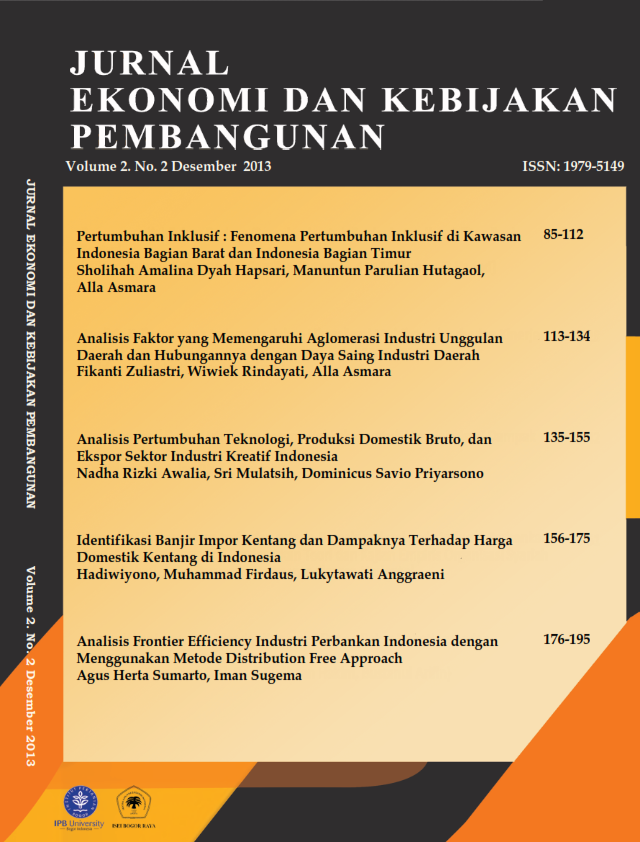ANALISIS FRONTIER EFFICIENCY INDUSTRI PERBANKAN INDONESIA DENGAN MENGGUNAKAN METODE DISTRIBUTION FREE APPROACH
Abstract
As an intermediary institution, bank has a very vital role in the economic development of a country so bank has to operate efficiently. The efficiency analysis can be conducted with the three approaches, namely cost efficiency, profit efficiency, and alternative profit efficiency. The three approaches can measured with two methode, parametric and non parametric. By using parametric methode (Distribution Free Approach), cost efficiency of 107 commercial banks operating for 10 years (2002- 2011), the average cost efficiency of banks in Indonesia is 0.6729. While the average value of the profit efficiency in Indonesian banks is 0.96363 or more efficient than cost efficiency. The score of alternative profit efficiency Indonesian banks is 0.965957. The cost efficiency of commercial banks on average have no strong correlation with all financial ratios of banks. The profit efficiency have a strong relationship with financial ratios ROA and BOPO. Financial performance of the bank's ROE ratio has a moderate correlation with the level of profit efficiency. While the level of alternative profit efficiency have a strong relationship with financial performance ratios ROE, ROA, and ROA. NIM ratio has a low relationship with alternative profit efficiency.
Keyword: Distributin Free Approach, Cost Efficiency, Profit Efficiency, and Alternative Profit Efficiency.
References
Akhtar MH. 2010. E-Efficiency Analysis of Pakistani Commercial Banks. International Management Review 6(1):12-24.
Baltagi BH. 2005. Econometric Analysis of Panel Data. England: John Wiley & Sons LTD.
Banerjee, Biswajit. 2012. Banking Sector Efficiency in New EU Member State: A Survey. Banka Slovenije. http://www.bsi.si/iskalniki/razisk ave.asp?MapaId=234. [10 Juli 2014].
Bank Indonesia. 2013. Statistik Perbankan Indonesia (SPI) bulan Januari 2013. http:// www. Bi.go.id. [6 Juni 2013].
Berger AN. et al. 1993. The Efficiency of Financial Institutions: A Review and Preview of Research Past, Present, and Future. Journal of Banking and Finance 17:221- 249.
Berger AN. Humprey DB. 1997. Efficiency of Financial Institution: International Survey and Direction for Future Research. fic.wharton.upenn.edu/. [7 Februari 2013].
Berger AN. Mester LJ. 1997. Inside the Black Box: What Explains Differences in The Efficiencies of Financial Institutions. fic.wharton.upenn.edu/. [7 Februari 2013].
Gujarati, Damodar N. (2004). Basic econometrics, fourth edition. The Mcgraw-Hill Companies.
Hadad MD. et al. 2003. Pendekatan Parametrik untuk Efisiensi Perbankan Indonesia. http://www.bi.go.id. [5 Juli 2012].
Mohamad, Karnoto. 2012. Berburu 115 Juta Unbanked. Majalah Infobank No.398. Jakarta.
Repkova I. Miglietti CL. 2014. Cost and Profit Efficiency of The Slovak Banking Sector. http://icfb.rs.opf.slu.cz/. [10 Juli 2014].
Sealey, C. And Lindley, J. 1977. Inputs, Outputs, and a theory of production and cost at depository financial institutions. Journal of Finance 32:1251-1266.
Sekretariat Negara. 1998. UndangUndang Republik Indonesia No. 10 Tahun 1998 tentang Perubahan atas Undang-Undang No. 7 Tahun 1992 tentang Perbankan. Jakarta.
Sillah BMS. et al. 2014. The Performance of Saudi Banking Industry 2000 -2011: Have the Banks Distinguished Themselves from One Another?. International Journal of Financial Research. www.sciedu.ca/ijfr. [10 Juli 2014].
Authors

This work is licensed under a Creative Commons Attribution-NonCommercial-ShareAlike 4.0 International License.
The authors who publis article(s) in Jurnal Ekonomi and Kebijakan Pembangunan have to understand and agree that the copyright of article published is owned by Jurnal ekonomi and Kebijakan pembangunan including to reproduce, distribute and sell this journal to public.





